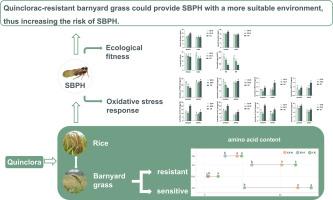抗喹喏拉克的越橘属植物可能通过提供更多的营养和稳定的环境促进了Laodelphax striatellus(半翅目:Delphacidae)的生长和繁殖
IF 4.2
1区 农林科学
Q2 BIOCHEMISTRY & MOLECULAR BIOLOGY
引用次数: 0
摘要
水稻是一种重要的农作物,在生长阶段面临着病原体、害虫和杂草的严峻挑战。同时,这些生物会相互影响,增加破坏程度。之前的研究表明,稗草(Echinochloa spp)可用作临时寄主,以增加主要多食性害虫之一的小褐飞虱(SBPH,Laodelphax striatellus)的侵扰。除草剂被广泛用于控制杂草抗药性的产生。然而,人们对杂草抗性增强对昆虫物种的影响知之甚少。在本研究中,我们研究了稗草(Echinochloa crus-galli var. zelayensis; Echinochloa crus-pavonis Schult)和水稻植株(五谷丰登 3 号)的抗喹啉酸生物型和敏感生物型对 SBPH 生态适应性的影响,并检测了植物和 SBPH 的生理指标,以探索其机制。结果表明,SBPH在抗喹禾灵稗草上饲养后,其生长和繁殖能力显著提高。从氧化应激反应的角度来看,抗性稗草上饲养的 SBPH 的过氧化物酶(POD)活性增加,过氧化氢酶(CAT)、混合功能氧化酶(MFO)和羧酸酯酶(CarE)活性降低。结合抗性稗草 E. crus-pavonis 中氨基酸含量(苏氨酸、丝氨酸、蛋氨酸和丙氨酸)的增加,我们推测抗喹禾灵的稗草可能为 SBPH 提供了更适宜的环境,从而增加了 SBPH 的风险。本文章由计算机程序翻译,如有差异,请以英文原文为准。

Quinclorac-resistant Echinochloa spp. promoted growth and reproduction of Laodelphax striatellus (Hemiptera: Delphacidae) probably by providing more nutrients and stable environment
Rice is an important agricultural crop that faces serious challenges from pathogens, pests, and weeds during growth stages. Meanwhile, these organisms would interact with each other to increase the level of destruction. The previous studies showed that barnyard grass (Echinochloa spp) could be used as a temporary host to increase infestation of small brown planthopper (SBPH, Laodelphax striatellus), which is one of the main polyphagous pests. Herbicides are widely used to control weeds that induce resistance development. However, little is known about the effects of increased weed resistance on insect species. In this study, we investigated the effect of quinclorac-resistant and sensitive biotypes of barnyard grass (Echinochloa crus-galli var. zelayensis; Echinochloa crus-pavonis Schult) and rice plants (Wuyujing 3) on the ecological fitness of SBPH and examined physiological indicators of plants and SBPH to explore the mechanism. Our results showed that the growth and reproduction of SBPH promoted significantly reared on quinclorac-resistant barnyard grass. From the perspectives of oxidative stress response, the activities of peroxidase (POD) increased and the activities of catalase (CAT), mixed-functional oxidase (MFO), and carboxylesterase (CarE) decreased in SBPH reared on resistant barnyard grass. Combined with the increased amino acid contents (threonine, serine, methionine, and alanine) of resistant barnyard grass E. crus-pavonis, we speculate that quinclorac-resistant barnyard grass probably provides SBPH with a more suitable environment, thus increasing the risk of SBPH.
求助全文
通过发布文献求助,成功后即可免费获取论文全文。
去求助
来源期刊
CiteScore
7.00
自引率
8.50%
发文量
238
审稿时长
4.2 months
期刊介绍:
Pesticide Biochemistry and Physiology publishes original scientific articles pertaining to the mode of action of plant protection agents such as insecticides, fungicides, herbicides, and similar compounds, including nonlethal pest control agents, biosynthesis of pheromones, hormones, and plant resistance agents. Manuscripts may include a biochemical, physiological, or molecular study for an understanding of comparative toxicology or selective toxicity of both target and nontarget organisms. Particular interest will be given to studies on the molecular biology of pest control, toxicology, and pesticide resistance.
Research Areas Emphasized Include the Biochemistry and Physiology of:
• Comparative toxicity
• Mode of action
• Pathophysiology
• Plant growth regulators
• Resistance
• Other effects of pesticides on both parasites and hosts.

 求助内容:
求助内容: 应助结果提醒方式:
应助结果提醒方式:


